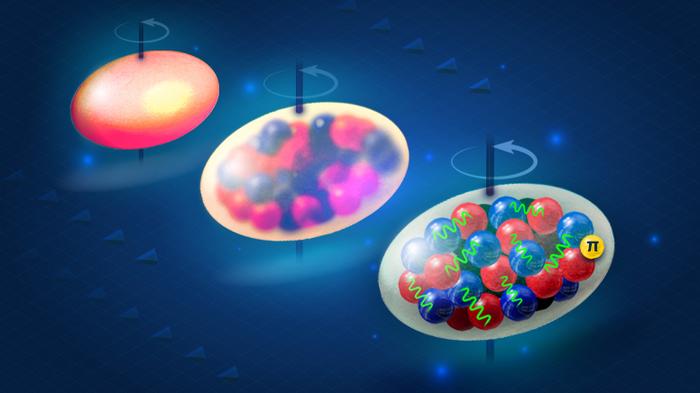
Using the cutting-edge technology of the Frontier supercomputer at the Department of Energy’s Oak Ridge National Laboratory (ORNL), a research team has unveiled a groundbreaking technique that enables unprecedented predictions of nuclear properties. By harnessing computational power previously thought unattainable, this innovative approach marks a significant leap forward in our understanding of nuclear physics. Researchers diligently explored the intricate structures that comprise atomic nuclei, unveiling a deeper connection to the fundamental forces that govern them. This foundational knowledge promises to catalyze progress across diverse fields, including quantum physics, energy generation, and national security.
The study illuminated the intricate relationship between nuclear structure and the strong force that holds atomic nuclei together. Delving into the complexities of nuclear forces, the researchers provided new insights that could fuel advancements in various scientific sectors. Zhonghao Sun from Louisiana State University, who previously conducted his research at ORNL, emphasized the significance of their reliable predictions, stating that they pave the way for transformative insights into nuclear structure and its forces. By effectively capturing the nuances of atomic behavior, this work sets the stage for substantial advancements in both theoretical and applied nuclear science.
Published in the esteemed journal Physical Review X, this study enhances our understanding of atomic nuclei at a granular, atomic scale. The research findings demonstrate the ability to accurately model the diverse shapes that atomic nuclei exhibit, from perfectly round to elongated, football-like configurations. Historically, capturing these variations in computational models has posed significant challenges, necessitating innovations that now leverage exascale computing capabilities. With the Frontier supercomputer operating at an astounding capacity of over a quintillion calculations per second, researchers can explore the atomic arrangements of particles with unprecedented detail.
As the researchers progressed from low to high resolution in their models, a fascinating shift in perspective emerged. Initially, nuclei could be understood as simple liquid drops that rotate. However, as computational resolution improved, the models unveiled intricate details regarding the internal structures of nuclei and how subatomic particles interact. Gaute Hagen from ORNL elaborated on this evolution of understanding, noting that such advancements critical to nuclear science reveal not just the shapes, but also the fascinating dynamics underlying nuclear interactions.
The study further revealed the characteristics of a rare nucleus, 30-neon, which intriguingly displays both round and deformed shapes concurrently. This discovery adds another layer of complexity to the understanding of nuclear forms and behaviors. The team conducted millions of simulations to explore how the strong nuclear force, responsible for maintaining the stability of atomic nuclei, contributes to this deformation. By establishing new models based on their computational insights, the researchers are not only revealing fundamental nuclear properties but are also facilitating future studies that can be executed on conventional laptops, broadening the reach of their findings.
Significantly, the researchers are transforming the landscape of computational nuclear physics with the introduction of these pioneering techniques. Sun noted that these methods represent a critical advancement, allowing for the accurate computation of deformed nuclear structures and behaviors. Such progress not only enhances the academic exploration of nuclear science but also holds promising implications for areas such as nuclear energy and even advancements in quantum computing.
Support for this transformative research came from the Department of Energy’s Office of Science, particularly through the Office of Nuclear Physics and the Office of Advanced Scientific Computing Research. The Frontier supercomputer, instrumental to these achievements, is housed at the Oak Ridge Leadership Computing Facility, a vital user facility for researchers pushing the boundaries of scientific inquiry. The collaborative efforts supported by the U.S. Department of Energy’s extensive funding into foundational physical sciences reflect a strategic commitment to addressing critical global challenges through scientifically rigorous research initiatives.
UT-Battelle, managing ORNL on behalf of the DOE Office of Science, also plays a fundamental role in fostering research that paves the way toward revolutionary breakthroughs in energy efficiency and national security applications. The Office of Science stands as the largest supporter of basic research in physical sciences in the United States, ensuring that promising avenues of research continue to receive the necessary backing.
This research not only advances academic knowledge but also places a spotlight on the dynamic capabilities of computational physics in revealing the mysteries of the atomic world. The unique findings underscore the importance of integrating advanced computational techniques with theoretical frameworks to foster a comprehensive understanding of subatomic phenomena.
Reflecting on their work, the research team anticipates that their findings will lay the groundwork for significant future studies, potentially leading to the development of new materials or nuclear technologies. By employing an interdisciplinary approach, these researchers are well positioned to impact various scientific domains, illustrating how nuclear science integrates seamlessly with broader physical principles.
In summary, this study represents a remarkable milestone in nuclear physics, propelled by the extraordinary capabilities of modern supercomputing. The implications of their findings extend well beyond academic circles, heralding the potential for real-world applications that could reshape our understanding and usage of nuclear technologies in the future.
As researchers continue to explore the intricacies of nuclear physics, the expectations are high for subsequent studies to build upon these novel techniques, pushing the boundaries of what we know about the atomic world and the forces that govern it.
Subject of Research: Nuclear properties and atomic nuclei
Article Title: Multiscale Physics of Atomic Nuclei from First Principles
News Publication Date: 10-Feb-2025
Web References: Physical Review X
References: None available
Image Credits: Güneş Özcan/ORNL, U.S. Dept. of Energy
Keywords
Nuclear physics, supercomputing, atomic structure, nuclear forces, computational simulation.
Tags: advancements in nuclear structure researchcomputational techniques in physicsenergy generation from nuclear insightsfoundational knowledge in nuclear forcesFrontier supercomputer technologyimplications for quantum physics researchinterdisciplinary applications of nuclear researchnational security and nuclear sciencepredictive modeling of atomic nucleistrong force in atomic nucleisupercomputing in nuclear physicstransformative insights into nuclear behavior





